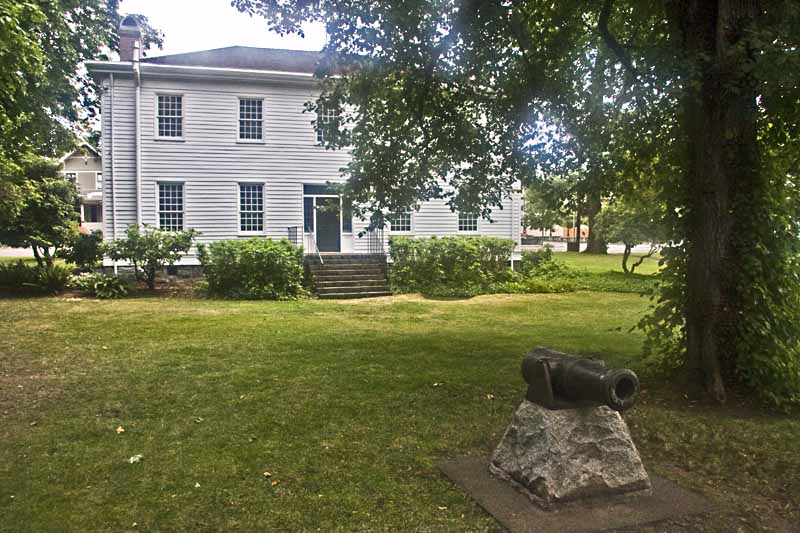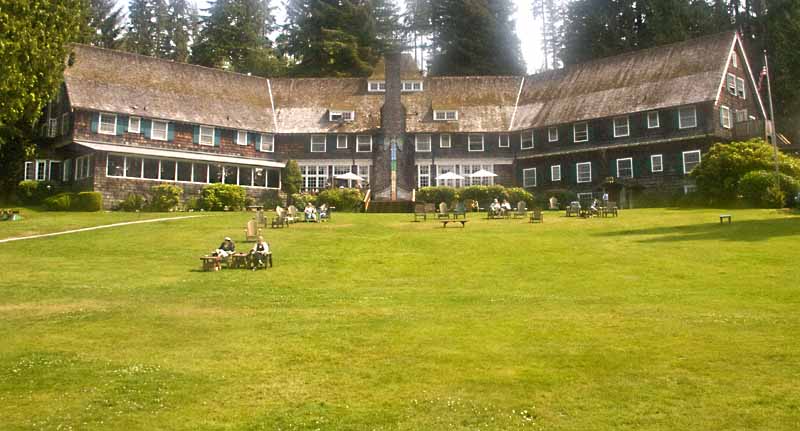A Scenic Drive in the Olympic Peninsula
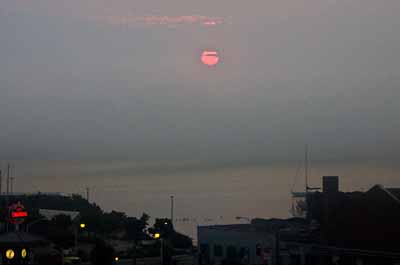 I awoke to the delightful sound of mournful fog horns ushering early ferries into their berths and a red sun climbing through the clouds of mist that hung just off the Strait of San Juan De Fuca. The motel's "expanded continental breakfast" turned out to be even less attractive than usual and I settled for a banana and coffee to go. From wake-up to departure was well within my normal half hour and I was in the car headed south to see the part of the coast that I had driven through in a cloud of endless dense mist the night before. My first order of business was to line up accommodations in the town of Forks. Because I was so early it was relatively easy to do. After assuring that I had a bed for the night, I had breakfast at the cafe recommended by the very nice lady working the morning shift on the motel desk. I have lived overseas much of my life and a lot of it in countries looked down on by most Americans as being part of the "Third World." I was well prepared for this cafe and it's morning offering.
I awoke to the delightful sound of mournful fog horns ushering early ferries into their berths and a red sun climbing through the clouds of mist that hung just off the Strait of San Juan De Fuca. The motel's "expanded continental breakfast" turned out to be even less attractive than usual and I settled for a banana and coffee to go. From wake-up to departure was well within my normal half hour and I was in the car headed south to see the part of the coast that I had driven through in a cloud of endless dense mist the night before. My first order of business was to line up accommodations in the town of Forks. Because I was so early it was relatively easy to do. After assuring that I had a bed for the night, I had breakfast at the cafe recommended by the very nice lady working the morning shift on the motel desk. I have lived overseas much of my life and a lot of it in countries looked down on by most Americans as being part of the "Third World." I was well prepared for this cafe and it's morning offering.
After my consumption of the calories necessary to sustain life, I drove south to Lake Quinault near the southern edge of the Olympic National Park. I drove through the Quinault Rain Forest and around the lake and then checked out the rather famous and very historic Quinault Lodge. Dramatic old "National Park Style" lodge in exactly the right location on a picture perfect lake. All of the cars parked in and around the lodge were expensive and the desk clerk told me that I had to check rates on the internet because they changed too often to print out on a rack card. My assumption is that the grand old lady is expensive, particularly on those days that the sun shines on her; but my assessment is that she is definitely the classiest place to stay on the entire western coast of the state. I did not have time to explore any of the hikes that they had in the immediate vicinity of the lodge, but my suspicion is that they were not as extensive as elsewhere in the park. The rain forest at the northeastern edge of the lake was interesting, but definitely not as dramatic as I was to see later in the day further to the north. In my opinion the lodge is a destination in and of itself and the rain forest is relegated to ambiance for those (like me) that enjoy classic decadence.
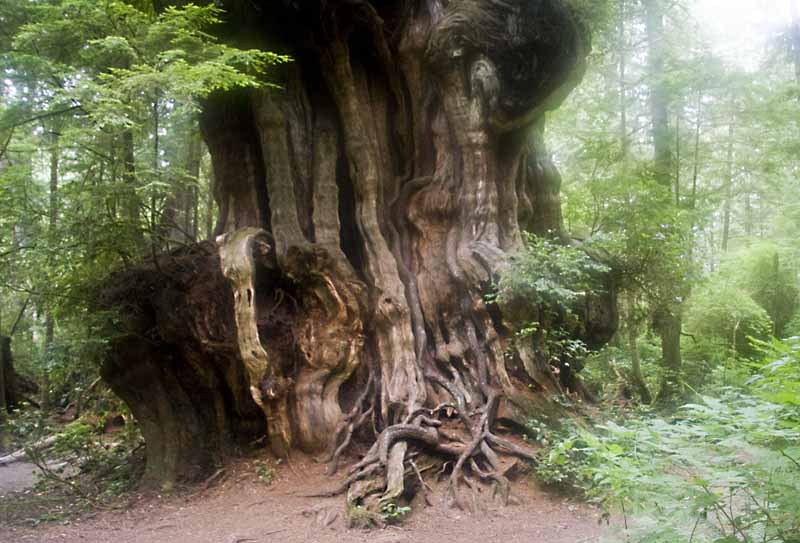 After the Quinault recon, I headed back north on Highway 101 and drove through a delightful section of the park that directly abuts the Pacific Ocean. This stretch of road has a half dozen turnouts that give access to the ocean beaches, but the prize attraction for me was a gigantic red cedar tree. I really like the signs in the Olympic National Park. Elsewhere, I have seen a large tree identified as being the tallest, or the biggest, or the oldest, or some other record achievement. Here the sign simply said "Big Cedar." The actual tree lived up to it's name and then some. I tried to put myself in the place of a Native American and to see the tree for it's usefulness. I succeeded pretty well in envisioning the use of the planks that break out naturally as lodging, but had more trouble as I tried to make twine, clothing, or packaging.
After the Quinault recon, I headed back north on Highway 101 and drove through a delightful section of the park that directly abuts the Pacific Ocean. This stretch of road has a half dozen turnouts that give access to the ocean beaches, but the prize attraction for me was a gigantic red cedar tree. I really like the signs in the Olympic National Park. Elsewhere, I have seen a large tree identified as being the tallest, or the biggest, or the oldest, or some other record achievement. Here the sign simply said "Big Cedar." The actual tree lived up to it's name and then some. I tried to put myself in the place of a Native American and to see the tree for it's usefulness. I succeeded pretty well in envisioning the use of the planks that break out naturally as lodging, but had more trouble as I tried to make twine, clothing, or packaging.
After the big cedar, I continued north on Highway 101 to the Hoh Rain Forest turnoff. This side road parallels the Hoh River and takes you twenty some miles deep into the Olympic National Forest to a Ranger Station and several excellent short hikes that give you a real taste of one of the largest old growth conifer forests left in the United States. This is what a rain forest should look like with a high green canopy, a lush undergrowth (at least where the elk have so permitted) and wispy club moss draped on virtually everything in sight. Water is everywhere - some of it in still ponds and some of it in quickly flowing streams and meandering rivers. It is easy to understand that precipitation is measured in feet not inches. One other thing that I appreciated about the Hoh Rain Forest is that all of the roads that I drove were paved. The Quinault Rain Forest roads were good, but they were gravel and thick gray dust covered everything in sight. In the Hoh, the roadside vegetation was as clean as the last rain. Oh, and the Hoh has a "Big Spruce" that is the size of a good sized redwood tree.
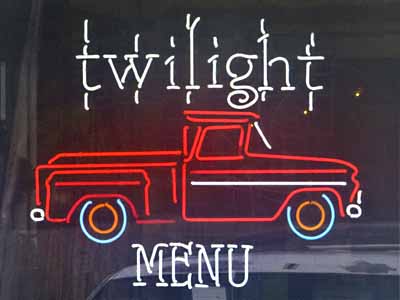 After several hours in the Hoh, I drove back to Forks, visited the information center, and walked around the town. There is not a whole lot to Forks, but I was interested to see how proud the town seemed to be of a recent series of vampire movies that had used the name of their town and the local school. Every storefront had some sort of allusion to the "Twilight." At first I thought that it was because of the gray weather that created something of a gloom, but then I began noticing the movie connection. After walking the town, I returned to my motel and asked where I should have dinner. The answer was a question - short and specific: "Chinese or Mexican?" I chose Mexican. If you are ever in Forks at dinner time you should probably at least give the Chinese a try.
After several hours in the Hoh, I drove back to Forks, visited the information center, and walked around the town. There is not a whole lot to Forks, but I was interested to see how proud the town seemed to be of a recent series of vampire movies that had used the name of their town and the local school. Every storefront had some sort of allusion to the "Twilight." At first I thought that it was because of the gray weather that created something of a gloom, but then I began noticing the movie connection. After walking the town, I returned to my motel and asked where I should have dinner. The answer was a question - short and specific: "Chinese or Mexican?" I chose Mexican. If you are ever in Forks at dinner time you should probably at least give the Chinese a try.
I was up earlier than most of Forks and got coffee and gasoline at the Shell Station (which I noticed was doing a pretty fair breakfast business of aluminum wrapped substances taken out of various steaming canisters). I drove north to Lake Crescent and checked out the Lodge (another picture perfect lake and another vintage lodge) and then headed east on Highway 101. I skipped Port Angeles and went on to Port Townsend for breakfast. My culinary luck did not change, but the town turned out to be very interesting and attractive and I actually ended up finding something in one of the shops that I had to purchase for my home. (Something that I do not do very often.) While in Port Townsend, I visited Forts Worden and Flagler which were part of the defensive facilities protecting access to the waterways leading to Seattle and then I headed south via a network of small roads to Quilcene where I rejoined Highway 101 - this time going south. At Hoodsport I took a side road back west into the Staircase Unit of the Olympic National Park. I got in another delightful short hike through a slightly less intense rain forest along another beautiful rushing stream.
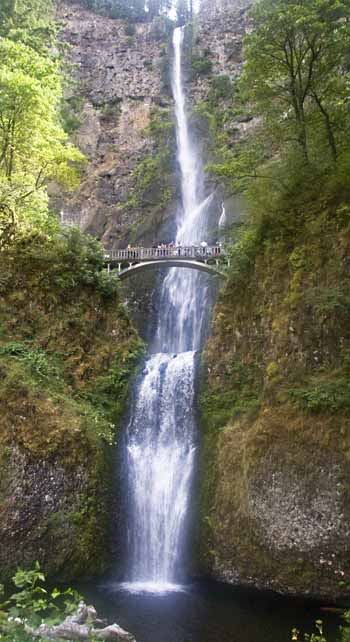 After the Staircase, I drove south on Highway 101 till it joined Interstate Highway 5 south of Olympia. Turning south on 5, I drove to Castle Rock in time to secure one of the last rooms in the motel and another bad meal in a roadside family diner. The next morning, in spite of the socked in state of the weather, I headed east on Highway 504 in the vague hope that I would be able to catch a glimpse of Mount Saint Helens. No luck. None. I returned through Castle Rock and drove south on 5 to Vancouver where I turned east on Highway 14. For no reason, I turned in at Camus and asked a vendor in a street fair where I should have breakfast. At last my luck changed and I was directed to the first good meal that I had on the entire trip - Russian meat crepes with fresh fruit on the side. Absolutely delicious! Natalia's small family-run cafe in Camus, Washington is very highly recommended.
After the Staircase, I drove south on Highway 101 till it joined Interstate Highway 5 south of Olympia. Turning south on 5, I drove to Castle Rock in time to secure one of the last rooms in the motel and another bad meal in a roadside family diner. The next morning, in spite of the socked in state of the weather, I headed east on Highway 504 in the vague hope that I would be able to catch a glimpse of Mount Saint Helens. No luck. None. I returned through Castle Rock and drove south on 5 to Vancouver where I turned east on Highway 14. For no reason, I turned in at Camus and asked a vendor in a street fair where I should have breakfast. At last my luck changed and I was directed to the first good meal that I had on the entire trip - Russian meat crepes with fresh fruit on the side. Absolutely delicious! Natalia's small family-run cafe in Camus, Washington is very highly recommended.
After breakfast I continued east on Highway 14 to the Bonneville Dam turnout. After admiring the dam for a moment or two I took another hour and walked the trail to where Fort Cascade and later the town of Cascade had been located in the middle of the nineteenth century. One of the things that constantly disappoints me is that things like the dam attract a steady flow of visitors, but there is almost no interest in what went before. The blockhouse is gone as are all of the vestiges of the town buildings, but there are still traces of the tramway that portaged goods around the massive cascade on the river and the grave of one of the original townspeople, Thomas McNatt, is still there. I find those things of equal importance to the dam and even more interest.
After the Cascade stop I went south across the Bridge of the Gods and then west on Highway 84. I turned off at the exit for Multnomah Falls and visited the three spectacular falls that stream down off of the high ground of the western end of the Columbia Gorge. (It was Saturday and they were all mobbed with visitors.) After admiring the falls, I continued west on Highway 84 to Interstate Highway 205 and turned south to Oregon City. it was late in the day and I made the mistake of visiting the cemetery before the McLoughlin House. As a result I missed getting into the house and I didn't even find Peter Ogden's grave site. I am not usually this inept, but it was pretty much par for the course on this trip. About the only bright spot in Oregon City was that my culinary luck held. I had an excellent cottage pie and a superb ale at the Highland Stillhouse at the south end of town above the Willamette River. After dinner, I drove back to Gold Beach.
Ok, don't do it the way that I did, but do it. Done properly - i.e. with reservations and including someone with whom to share things - it would be a delightful trip. In fact, I intend to do it that way at some point in the not too distant future. As I envision it, the trip would start in Astoria and end in Oregon City. The first stop would be Astoria with visits to the Lewis and Clark sites and Fort Stevens that first day. There is some very good food in Astoria and some interesting shops, museums, and other urban attractions. The second day would be devoted to a leisurely drive up to Lake Quinault with a decadent overnight at the Lodge. The third day would start early with a visit to the Hoh River Rain Forest and then on to the Lodge at Lake Crescent. The fourth day would start with a walk to the waterfall near the lodge and then move on to Port Townsend and one of the small hotels in town. The fifth day would include a ferry ride across to the San Juan Islands and then on into Seattle. The sixth day would be in Seattle, with a seventh that would include a quick viewing of Mount Saint Helens and conclude in Oregon City. Obviously, if you are uninterested in the Father of the American Northwest and the early history of this region you could include the ale houses of Portland instead, but for me one metropolis a trip is enough. I would save Portland to be the urban attraction another time.
